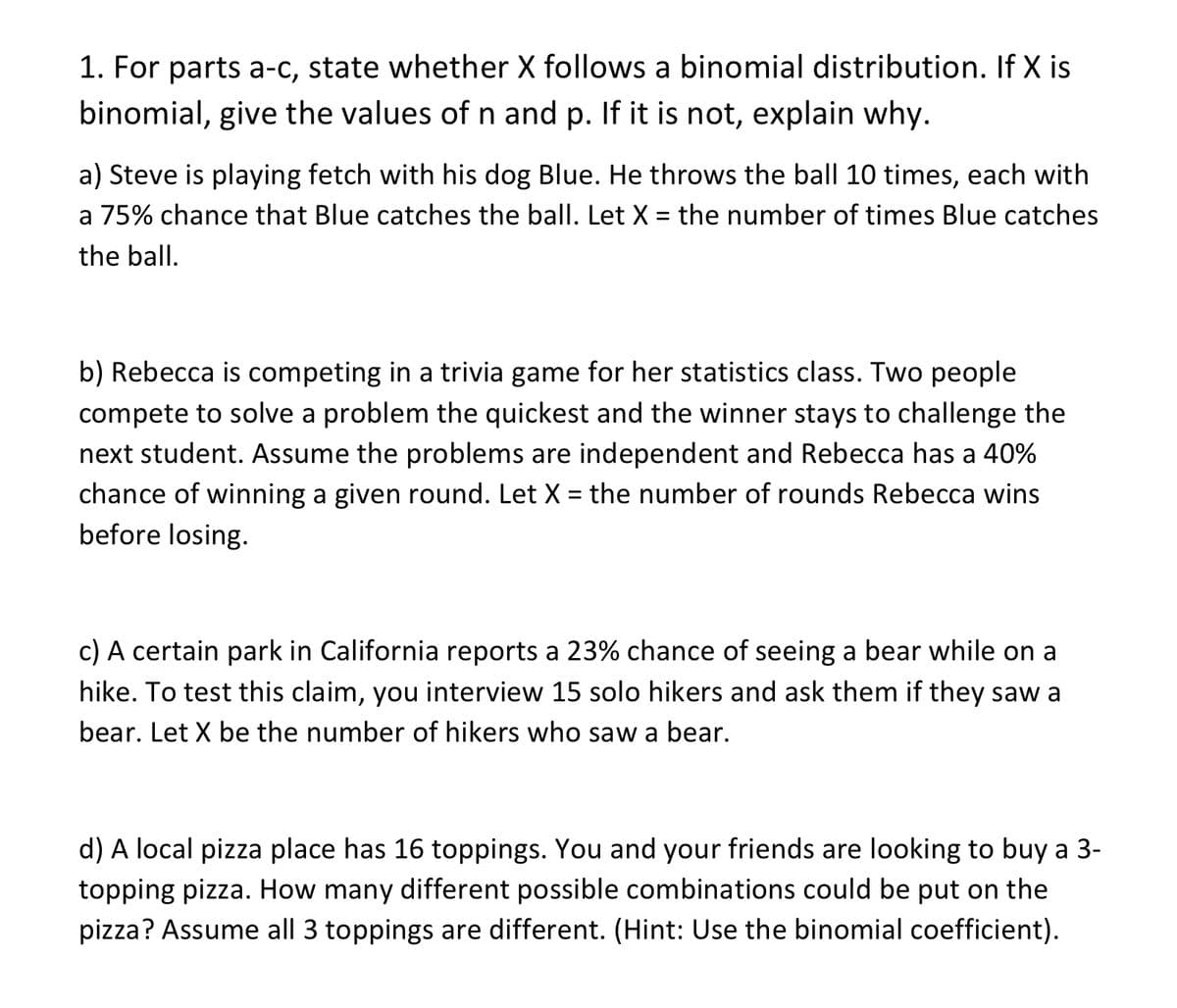1. For parts a-c, state whether X follows a binomial distribution. If X is binomial, give the values of n and p. If it is not, explain why. a) Steve is playing fetch with his dog Blue. He throws the ball 10 times, each with a 75% chance that Blue catches the ball. Let X = the number of times Blue catches the ball. b) Rebecca is competing in a trivia game for her statistics class. Two people compete to solve a problem the quickest and the winner stays to challenge the next student. Assume the problems are independent and Rebecca has a 40% chance of winning a given round. Let X = the number of rounds Rebecca wins before losing. c) A certain park in California reports a 23% chance of seeing a bear while on a hike. To test this claim, you interview 15 solo hikers and ask them if they saw a bear. Let X be the number of hikers who saw a bear. d) A local pizza place has 16 toppings. You and your friends are looking to buy a 3- topping pizza. How many different possible combinations could be put on the pizza? Assume all 3 toppings are different. (Hint: Use the binomial coefficient).
1. For parts a-c, state whether X follows a binomial distribution. If X is binomial, give the values of n and p. If it is not, explain why. a) Steve is playing fetch with his dog Blue. He throws the ball 10 times, each with a 75% chance that Blue catches the ball. Let X = the number of times Blue catches the ball. b) Rebecca is competing in a trivia game for her statistics class. Two people compete to solve a problem the quickest and the winner stays to challenge the next student. Assume the problems are independent and Rebecca has a 40% chance of winning a given round. Let X = the number of rounds Rebecca wins before losing. c) A certain park in California reports a 23% chance of seeing a bear while on a hike. To test this claim, you interview 15 solo hikers and ask them if they saw a bear. Let X be the number of hikers who saw a bear. d) A local pizza place has 16 toppings. You and your friends are looking to buy a 3- topping pizza. How many different possible combinations could be put on the pizza? Assume all 3 toppings are different. (Hint: Use the binomial coefficient).
College Algebra
7th Edition
ISBN:9781305115545
Author:James Stewart, Lothar Redlin, Saleem Watson
Publisher:James Stewart, Lothar Redlin, Saleem Watson
Chapter9: Counting And Probability
Section9.3: Binomial Probability
Problem 2E: If a binomial experiment has probability p success, then the probability of failure is...
Related questions
Question
ONLY PART D.!! PLEASE

Transcribed Image Text:1. For parts a-c, state whether X follows a binomial distribution. If X is
binomial, give the values of n and p. If it is not, explain why.
a) Steve is playing fetch with his dog Blue. He throws the ball 10 times, each with
a 75% chance that Blue catches the ball. Let X = the number of times Blue catches
the ball.
b) Rebecca is competing in a trivia game for her statistics class. Two people
compete to solve a problem the quickest and the winner stays to challenge the
next student. Assume the problems are independent and Rebecca has a 40%
chance of winning a given round. Let X = the number of rounds Rebecca wins
%3D
before losing.
c) A certain park in California reports a 23% chance of seeing a bear while on a
hike. To test this claim, you interview 15 solo hikers and ask them if they saw a
bear. Let X be the number of hikers who saw a bear.
d) A local pizza place has 16 toppings. You and your friends are looking to buy a 3-
topping pizza. How many different possible combinations could be put on the
pizza? Assume all 3 toppings are different. (Hint: Use the binomial coefficient).
Expert Solution
This question has been solved!
Explore an expertly crafted, step-by-step solution for a thorough understanding of key concepts.
Step by step
Solved in 2 steps

Recommended textbooks for you

College Algebra
Algebra
ISBN:
9781305115545
Author:
James Stewart, Lothar Redlin, Saleem Watson
Publisher:
Cengage Learning

College Algebra
Algebra
ISBN:
9781305115545
Author:
James Stewart, Lothar Redlin, Saleem Watson
Publisher:
Cengage Learning